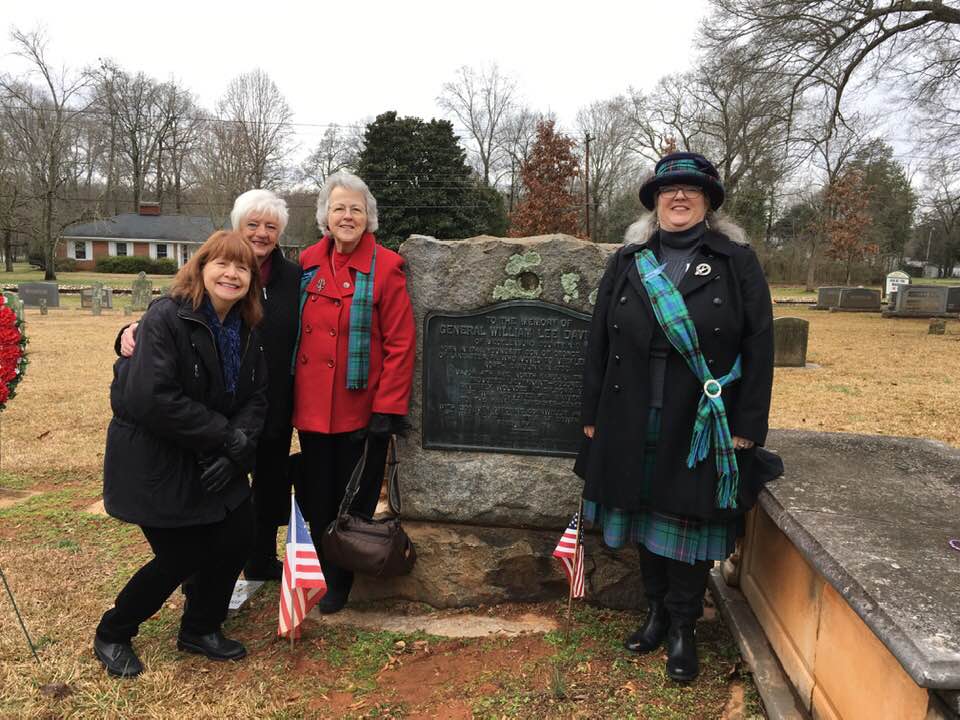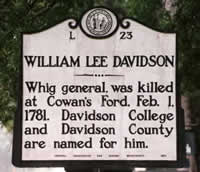General William Lee Davidson
Brigadier General William Lee Davidson, for whom our chapter and county were named, was born simply as “William Davidson” in Lancaster, Pennsylvania, in 1746, son of George and Margaret Ware Davidson. As an adult he added the middle name “Lee” from admiration for General “Light Horse” Harry Lee, whom Davidson befriended when he overwintered with the Continental Army at Valley Forge. In about 1750 the family relocated to a rural area near what is now Charlotte, North Carolina.

Davidson was one of eight children. His parents died young, and Davidson and his siblings were raised with their cousins, virtually all of whom would go on to Revolutionary involvements. Male Davidsons fought in major battles and built the westernmost fort of the era, “Davidson’s Fort,” near what is now Asheville, North Carolina. One cousin, John Davidson, signed the Mecklenburg Declaration, considered by some a forerunner to the U.S. Declaration of Independence. Female Davidsons married into prominent families; the husband of another cousin, Elizabeth Davidson McLean, was one of the first elected officials in Nashville. Elizabeth’s husband Ephraim signed the 1783 petition creating the Tennessee county and naming it for General Davidson.
As a youth, Davidson attended Presbyterian Sugar Creek Academy, where he studied under the notorious Revolutionary firebrand Reverend Alexander Craighead. Craighead’s son Thomas would later become the founding president of Davidson Academy, the first institute of higher learning west of the Appalachians. The school was founded north of Nashville shortly after the city’s incorporation and named for General Davidson. Its initial board of trustees included Nashville founder James Robertson and future U.S. President Andrew Jackson.
Davidson married Mary Brevard on December 10, 1767. They would become parents to seven children. Davidson’s military career also began that year, when he helped escort Colonial Governor William Tryon on a surveying mission into Cherokee territory. After taking the oath of allegiance to King George III, as required by law, Davidson was commissioned captain in the Rowan County militia. However, in May 1775, the Mecklenburg Committee of Safety was organized as a government independent of the King, with several Davidson family members among its founders and contributing to what British Lord Cornwallis called a “hornet’s nest of rebellion.” Later that year William Davidson was appointed major in the Continental Army.
Davidson was at the Battle of Germantown, after which he was promoted to lieutenant colonel. At Valley Forge, he studied under Baron von Steuben and befriended most of the influential Continental Line commanders. Severely wounded at the Battle of Colson’s Mill on July 21, 1780, he was unable to participate in battles that fall such as Camden or Kings Mountain, though colonels mustering their forces to attack the British under Ferguson petitioned for General Davidson to command them.
Upon his convalescence, Davidson was promoted to brigadier general and given command of the Salisbury District militia. Davidson enjoyed a particular talent for recruitment; the men he enlisted fought crucial battles throughout the Southern campaign.
On February 1, 1781, Davidson was fatally wounded at the Battle of Cowan’s Ford, after an agreement with Generals George Washington, Nathanael Greene, and others to slow down British commanders Cornwallis and Tarleton as they attempted to re-enter North Carolina after Cowpens. Six weeks later the Continental Army routed the British at Guilford Courthouse, leading to a British surrender at Yorktown and an end to the war.
Upon his death, the British seized several items belonging to Davidson, including a wallet containing instructions from General Washington. The wallet is now held at London’s National Archives. A sword and handgun belonging to General Davidson may be seen at the Guilford Courthouse National Military Park near Greensboro.
Brigadier General William Lee Davidson was quickly buried in the churchyard of Hopewell Presbyterian Church near Charlotte, organized by Craighead parishioners. For many years Davidson’s grave was left unmarked out of fear that political opponents might defile the famous general’s remains. In 1905 a monument to General Davidson was erected at Guilford Courthouse, but it was later dismantled.

In 1920, the Mecklenburg Declaration of Independence Chapter, NSDAR, erected a gravesite memorial to General Davidson. Another memorial to Davidson is maintained at Nashville’s Davidson County Courthouse. Davidson College in North Carolina, founded by William Lee Davidson II, is also named for General Davidson, as are the town and county of the same name in the Tar Heel State.
General Davidson’s family settled north of Nashville on 5,700 acres granted for his service. Several of his children remained in the area. His daughter Peggy married Reverend Finis Ewing of Nashville’s well-known political family and a founder of the modern Cumberland Presbyterian Church. Davidson’s widow Mary Brevard Davidson remarried and eventually settled near Russellville, Kentucky, about an hour north of Nashville. She is believed to be buried on land once owned by her daughter Pamela Davidson McLean, though her grave remains unmarked.
Prepared by Jean Carter Wilson


